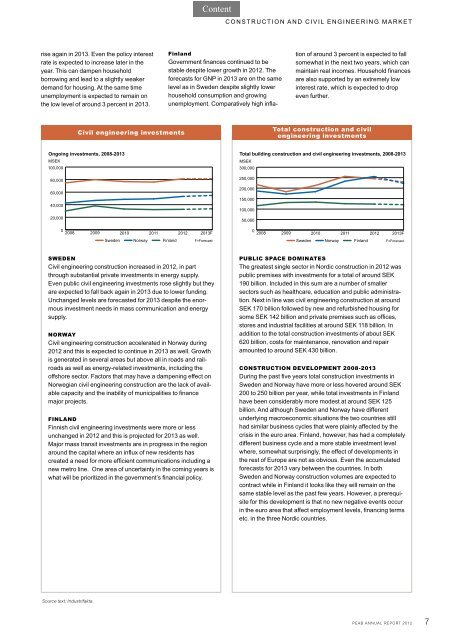Create successful ePaper yourself
Turn your PDF publications into a flip-book with our unique Google optimized e-Paper software.
ise again in 2013. Even the policy interest<br />
rate is expected to increase later in the<br />
year. This can dampen household<br />
borrowing and lead to a slightly weaker<br />
demand for housing. At the same time<br />
unemployment is expected to remain on<br />
the low level of around 3 percent in 2013.<br />
MSEK<br />
Civil engineering investments<br />
Ongoing investments, 2008-2013<br />
100,000<br />
80,000<br />
60,000<br />
40,000<br />
20,000<br />
0<br />
2008 2009<br />
2010<br />
2011<br />
Sweden Norway Finland<br />
<strong>2012</strong><br />
2013F<br />
F=Forecast<br />
SWEDEN<br />
Civil engineering construction increased in <strong>2012</strong>, in part<br />
through substantial private investments in energy supply.<br />
Even public civil engineering investments rose slightly but they<br />
are expected to fall back again in 2013 due to lower funding.<br />
Unchanged levels are forecasted for 2013 despite the enormous<br />
investment needs in mass communication and energy<br />
supply.<br />
NORWAY<br />
Civil engineering construction accelerated in Norway during<br />
<strong>2012</strong> and this is expected to continue in 2013 as well. Growth<br />
is generated in several areas but above all in roads and railroads<br />
as well as energy-related investments, including the<br />
offshore sector. Factors that may have a dampening effect on<br />
Norwegian civil engineering construction are the lack of available<br />
capacity and the inability of municipalities to finance<br />
major projects.<br />
FINLAND<br />
Finnish civil engineering investments were more or less<br />
unchanged in <strong>2012</strong> and this is projected for 2013 as well.<br />
Major mass transit investments are in progress in the region<br />
around the capital where an influx of new residents has<br />
created a need for more efficient communications including a<br />
new metro line. One area of uncertainty in the coming years is<br />
what will be prioritized in the government’s financial policy.<br />
Source text: Industrifakta.<br />
Finland<br />
Government finances continued to be<br />
stable despite lower growth in <strong>2012</strong>. The<br />
forecasts for GNP in 2013 are on the same<br />
level as in Sweden despite slightly lower<br />
household consumption and growing<br />
unemployment. Comparatively high infla-<br />
CONSTRUCTION AND CIVIL ENGINEERING MARKET<br />
MSEK<br />
Total construction and civil<br />
engineering investments<br />
Total building construction and civil engineering investments, 2008-2013<br />
300,000<br />
250,000<br />
200,000<br />
150,000<br />
100,000<br />
50,000<br />
0<br />
2008 2009<br />
tion of around 3 percent is expected to fall<br />
somewhat in the next two years, which can<br />
maintain real incomes. Household finances<br />
are also supported by an extremely low<br />
interest rate, which is expected to drop<br />
even further.<br />
2010<br />
2011<br />
Sweden Norway Finland<br />
<strong>2012</strong> 2013F<br />
F=Forecast<br />
PUBLIC SPACE DOMINATES<br />
The greatest single sector in Nordic construction in <strong>2012</strong> was<br />
public premises with investments for a total of around SEK<br />
190 billion. Included in this sum are a number of smaller<br />
sectors such as healthcare, education and public administration.<br />
Next in line was civil engineering construction at around<br />
SEK 170 billion followed by new and refurbished housing for<br />
some SEK 142 billion and private premises such as offices,<br />
stores and industrial facilities at around SEK 118 billion. In<br />
addition to the total construction investments of about SEK<br />
620 billion, costs for maintenance, renovation and repair<br />
amounted to around SEK 430 billion.<br />
CONSTRUCTION DEVELOPMENT 2008-2013<br />
During the past five years total construction investments in<br />
Sweden and Norway have more or less hovered around SEK<br />
200 to 250 billion per year, while total investments in Finland<br />
have been considerably more modest at around SEK 125<br />
billion. And although Sweden and Norway have different<br />
underlying macroeconomic situations the two countries still<br />
had similar business cycles that were plainly affected by the<br />
crisis in the euro area. Finland, however, has had a completely<br />
different business cycle and a more stable investment level<br />
where, somewhat surprisingly, the effect of developments in<br />
the rest of Europe are not as obvious. Even the accumulated<br />
forecasts for 2013 vary between the countries. In both<br />
Sweden and Norway construction volumes are expected to<br />
contract while in Finland it looks like they will remain on the<br />
same stable level as the past few years. However, a prerequisite<br />
for this development is that no new negative events occur<br />
in the euro area that affect employment levels, financing terms<br />
etc. in the three Nordic countries.<br />
PEAB ANNUAL REPORT <strong>2012</strong><br />
7


